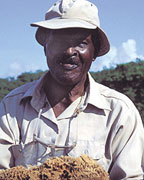
 National Park Service to honor Black Floridian Conservationist
National Park Service to honor Black Floridian Conservationist
By Audrey Peterman
The Joneses bought their first island in Biscayne Bay in 1897 and lived there continuously until 1992. In the course of nearly a century, the African American family carved a prosperous livelihood out of limestone rock; raised two sons fluent in the language of land and sea; consorted with American presidents and elites, and ultimately saved the Bay to create Biscayne National Park.
On Monday, Oct. 12, 2015 the National Park Service will honor the family’s youngest son, Sir Lancelot Jones, who resisted the blandishments of real estate developers and sold his island intact to the Service in 1970s. According to a release from the park, “The Lancelot Jones Day commemoration will take place from 11 a.m. to noon at the Dante Fascell Visitor Center, 9700 S.W. 328 St., Homestead. The event is presented by the National Park Service in partnership with the City of Homestead, Miami-Dade and Monroe Counties, the National Parks Conservation Association and Mahogany Youth.”
Without Sir Lancelot’s determination to protect his ancestral island, Biscayne today might be another version of Miami Beach instead of the largest marine park in the National Park System.
Frank and I first heard the story of the Jones family in the mid-90s from our friend Ranger Brenda Lanzendorf. She was eager for the story to take its rightful place in the interpretation of the park’s history and culture.
As we relate in “Legacy on the Land: A Black Couple Dis-covers Our Natural Inheritance and Tells Why Every American Should Care,” (2009),
“Brenda was piecing together the story of the Jones family, African Americans who at one time owned two islands outright, and part of a third island in the park. She was studying Porgy Key where the foundations of the Jones family house stood, and found many relics from the family’s isolated life in the middle of the bay. She was eager to engage people in the local community in the effort to research and document the family’s history, and to have their story highlighted as a feature of the park. For our part, it was a thrill to learn about the Joneses and to help publicize their incredible achievements. . .”
Ranger Lanzendorf modeled respect for the local community and engaged community leaders, students and the media to help unearth and publicize the story. She took us and other members of the South Florida Community Partners (consisting mainly of non-white advocates and park staff) to Porgy Key and showed us how cleverly the family worked to maintain life on the coral rock island. She showed us the water collection system they developed to provide their fresh water, and the unique farming methods they used, including packing coral around the roots on their lime and pineapple plantation to hold in the moisture. In the early 1900s the Joneses were the biggest suppliers of key limes and pineapples from Miami to Key West.
Ranger Lanzendorf also engaged seniors at nearby Home-stead High School in a research project to collect historical facts about the family. After weeks of research on their own time on Saturday mornings, they presented a stirring report to the park which Ranger Lanzendorf incorporated into the displays at the Visitor Center. “I never came into this park before and I never knew this story,” said one young man. “The lesson I’ve learned is that it’s not just about the opportunities you are given, but the opportunities you can create for yourself.”
Over many years the Community Partners including such luminaries as historian Gene Tinnie political commentator Al Calloway, and environmentalist Nadine Patrice have taken local leaders to Biscayne to share this story, Mrs. Athalie Range, the first Black woman to hold a cabinet position in Florida, was stunned to the point of tears as she sat on the deck at Convoy Point and looked out across the bay.
“You mean, when we were fighting for a little strip of beach where Black people could go, and finally got Virginia Key with those terrible currents, there were Black people that owned islands right here in Miami? And we didn’t know?”
Exactly. Examples of Black contributions to the development of America abounds in the National Park System, but few people know about them. Sir Lancelot Jones was the prized bone-fishing guide sought after by Herbert Hoover, Richard Nixon and Lyndon Johnson when they visited the Cocolobo Club across the channel.
Now, with the leadership of Mahogany Youth and the Na-tional Parks Conservation Association among others, Miami-Dade and Monroe Counties have proclaimed October 12, Lancelot Jones Day. The Florida Legislature proclaimed October 12, 2015 Lancelot Jones Day, as a one-time designation. The City of Homestead and Miami-Dade County are renaming 328th Street from Speedway Boulevard to Biscayne National Park entrance “Sir Lancelot Jones Way.”
So come on out and support our local national hero! And maybe now we can ask the Park Service to take the next step in fulfilling Ranger Lanzendorf’s dream:
“I want people around the world to hear about this family and say, ‘I have to go see this site.’ We have to stabilize the ruins and develop a visitor plan that allows people to visit the site without destroying the natural resources. We could put in a floating dock so that people can have access without changing the character of the island…” she told me on her death bed in 2008.
We can start by asking Biscayne Superintendent Brian Carlstrom about it October 12. See you there!


Be the first to comment